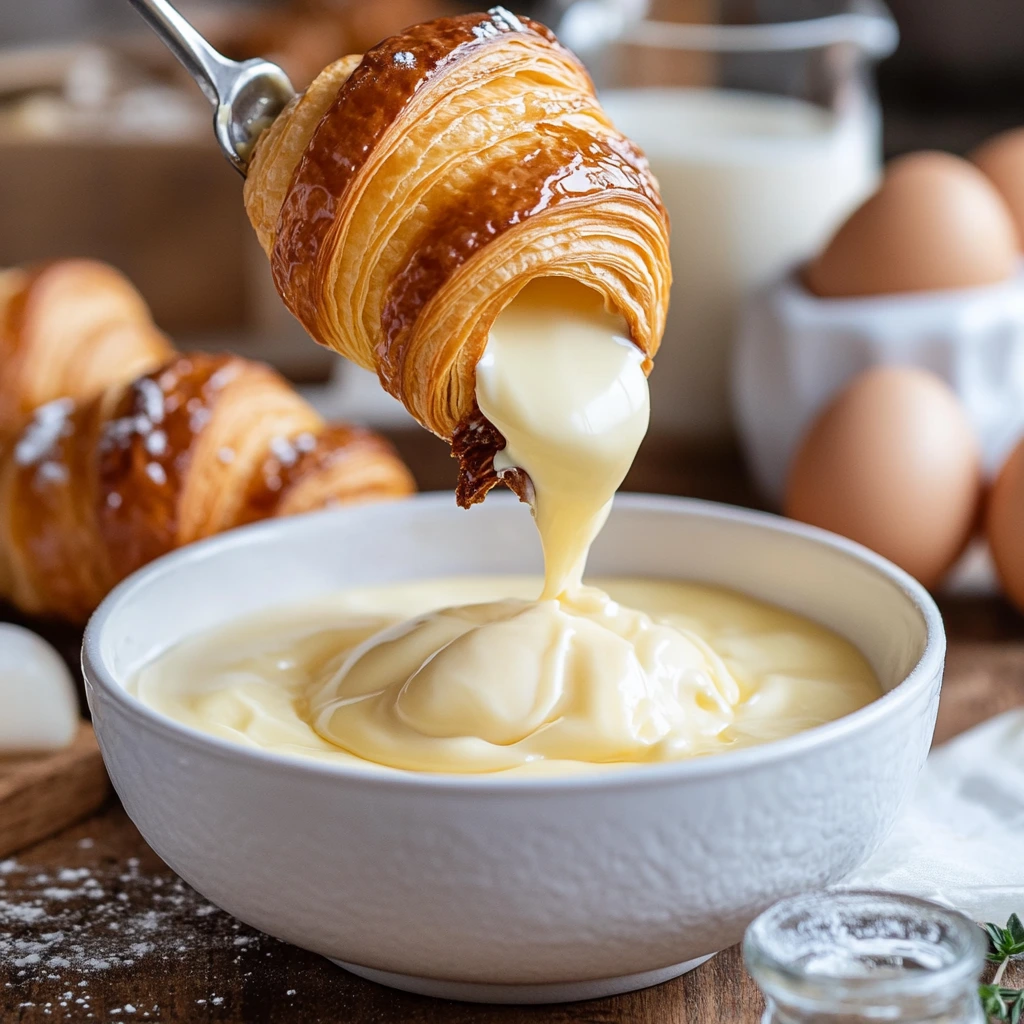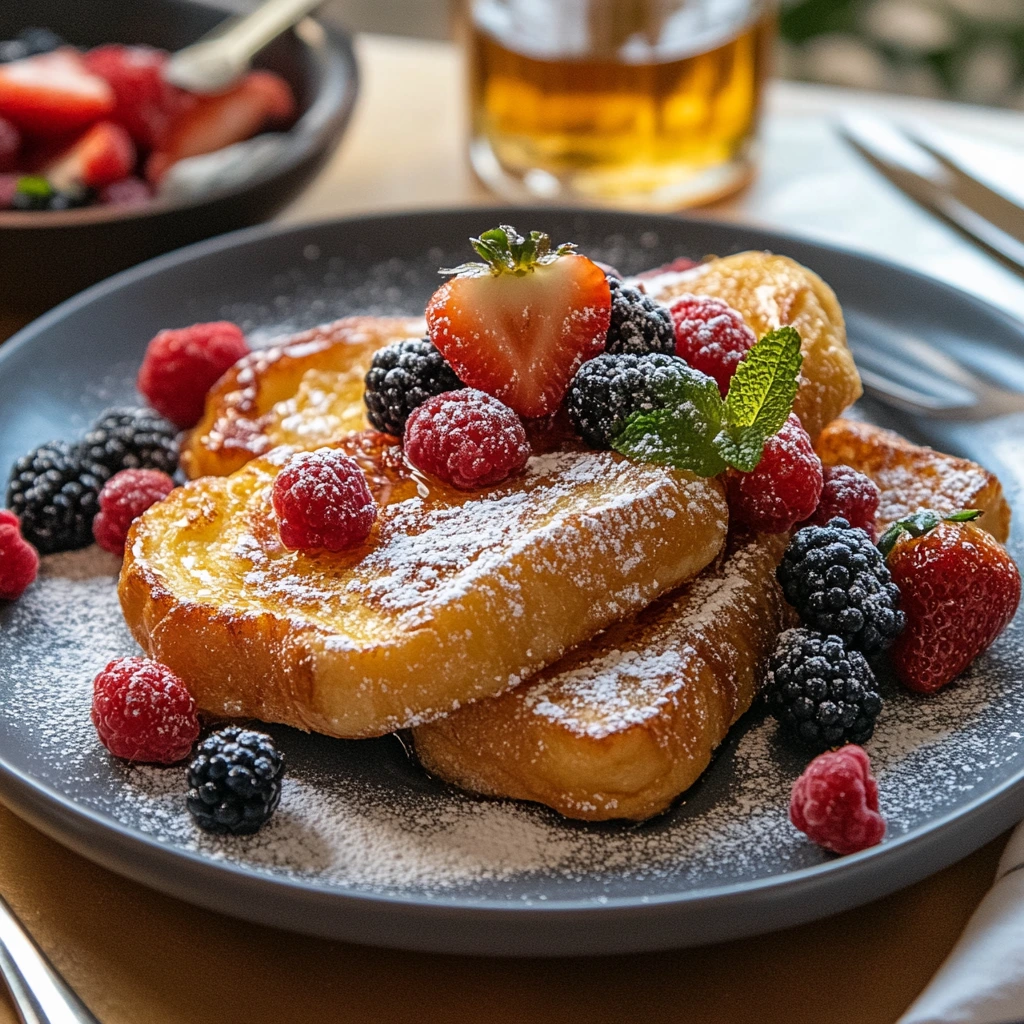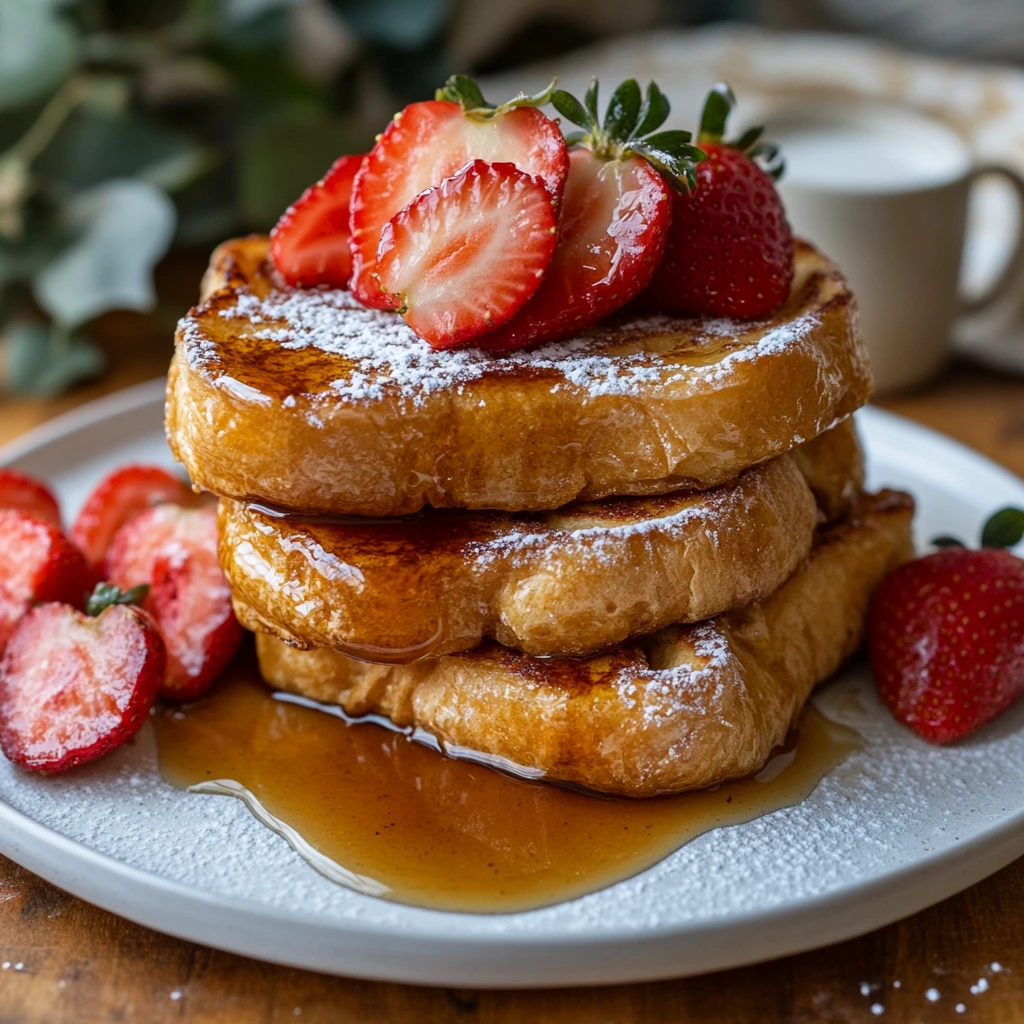If you’re searching for a truly indulgent breakfast or brunch option, a Croissant French Toast recipe is the perfect choice. French toast, a beloved classic made by soaking bread in a rich egg custard and cooking it to golden perfection, has evolved over time with endless variations. While traditional recipes often call for sliced bread, using croissants as the base takes this dish to a whole new level of decadence.
Croissants, with their buttery, flaky layers and tender texture, make an excellent foundation for French toast. Not only do they absorb the egg mixture beautifully, but they also add a luxurious, pastry-like quality that elevates the recipe. The result is a dish that balances a custard-like interior with a crispy, golden-brown exterior, creating a delightful harmony of flavors and textures.
This Croissant French Toast recipe has gained widespread popularity for its irresistible richness and versatility. It pairs wonderfully with a variety of toppings, such as fresh fruit, powdered sugar, or a drizzle of maple syrup, making it a crowd-pleaser for any occasion. Whether you’re hosting a weekend brunch or treating yourself to a special breakfast, this recipe is sure to impress and satisfy.
Table of Contents
1. Why Choose Croissants for French Toast?
Croissants are the perfect choice for making French toast because of their buttery and flaky texture. Unlike regular bread, which can be plain and dense, croissants add a rich and pastry-like quality to the dish. This makes every bite more flavorful and indulgent.
Using day-old croissants is even better for this recipe. Slightly stale croissants soak up the egg mixture without becoming soggy. This creates the ideal French toast: soft and creamy on the inside with a golden, crispy outside.
Compared to traditional bread, croissants take French toast to the next level. Their unique texture and rich taste make them an easy way to turn a simple breakfast into a special treat. Whether for a cozy morning at home or an elegant brunch, croissants make your French toast extra delicious and memorable.
2. Ingredients Needed for Croissant French Toast Recipe

To make a delicious Croissant French Toast, you’ll need the following ingredients:
- Croissants: Use fresh or day-old croissants for the best texture and flavor.
- Eggs: Essential for creating the custard base that soaks into the croissants.
- Milk or Cream: Adds richness to the custard mixture; choose cream for a more indulgent dish.
- Sugar: Sweetens the custard; adjust to your taste.
- Vanilla Extract: Enhances the flavor with a warm, aromatic touch.
- Cinnamon (Optional): Adds a hint of spice for extra warmth and depth.
- Butter: For cooking the French toast to golden perfection in the pan.
Optional Toppings: Complete your Croissant French Toast with any combination of the following:
- Maple syrup
- Fresh berries (e.g., strawberries, blueberries, raspberries)
- Powdered sugar
- Whipped cream
- Chopped nuts
These simple ingredients come together to create an indulgent and flavorful breakfast treat.
2.1. Selecting the Right Croissants
Choosing the right croissants is important for making the best Croissant French Toast. Here are a few tips:
- Go for plain, buttery croissants: Their rich flavor and flaky layers make them perfect for soaking up the custard. Avoid croissants with fillings like chocolate or almond, as these can overpower the dish.
- Use slightly stale croissants: Day-old croissants work best because they are firmer and soak up the egg mixture without getting too soggy. This helps create a soft, creamy inside and a crispy, golden outside.
- Fresh croissants can work too: If you only have fresh ones, they’ll still be delicious, but handle them carefully as they’re more delicate.
By picking plain and slightly stale croissants, you’ll make sure your French toast is flavorful, easy to prepare, and perfectly textured.
3. Preparing the Custard Mixture
Creating the perfect custard mixture is essential for making Croissant French Toast rich and flavorful. Follow these simple steps for the best results.
3.1. Step-by-Step Instructions:
- Whisk the Ingredients: In a large bowl, whisk together eggs, milk or cream, sugar, vanilla extract, and cinnamon (if using). Aim for a smooth and well-combined mixture with no streaks of egg yolk or whites.
- Achieve the Right Consistency: The custard should be thick enough to coat the croissants without being too runny. If the mixture feels too thin, consider adding a touch more cream or an extra egg.
- Prepare for Soaking: Once ready, pour the custard into a shallow dish to make it easier to soak the croissants evenly. Allow each croissant half to soak for a few seconds, ensuring they absorb the mixture without falling apart.
3.2. Optional Variations:
- Nutmeg: Add a pinch of ground nutmeg to the custard for a warm, spiced flavor.
- Orange Zest: Grate a bit of orange zest into the mixture for a fresh and citrusy twist.
By carefully preparing your custard mixture and experimenting with variations, you can customize your Croissant French Toast to suit any taste!
4. Soaking the Croissants
Properly soaking the croissants is a key step in achieving the perfect balance of flavor and texture in your Croissant French Toast. Follow these guidelines to get it just right.
Guidelines for Soaking:
- Slice the Croissants Horizontally: Start by slicing each croissant in half horizontally. This creates two even pieces that soak up the custard mixture more uniformly.
- Dip Each Piece Carefully: Place one croissant half at a time into the prepared custard mixture. Let it sit for 5–10 seconds per side, depending on the croissant’s freshness. Fresh croissants will absorb faster, while day-old croissants may take a bit longer.
- Ensure Even Absorption: Make sure the custard coats the croissants thoroughly, but avoid letting them become too soggy. Oversoaking can cause the croissants to fall apart and lose their flaky texture.
- Work in Batches: To avoid crowding, soak only a few croissant halves at a time. This makes it easier to handle them without tearing.
Maintaining the croissant’s delicate structure while ensuring it absorbs the custard is key to a successful dish. With just the right amount of soaking, you’ll achieve a soft, custard-like interior and a crisp, golden exterior for a truly indulgent breakfast.
5. Cooking Techniques
When it comes to making Croissant French Toast, you can choose between two primary cooking methods: the stovetop method or the baking method. Each has its own benefits, so pick the one that best suits your needs.
Stovetop Method
- Heat Butter in a Skillet: Start by heating a generous amount of butter in a non-stick skillet over medium heat. The butter should melt completely and sizzle lightly, but not burn.
- Cook Until Golden Brown: Place the soaked croissants in the skillet and cook for 2–4 minutes per side, or until golden brown and crisp. Flip carefully to avoid breaking the croissants.
- Serve Warm: Once both sides are evenly cooked, transfer the croissants to a plate and serve immediately.
Pros: Quick and allows for better control over browning.
Cons: Requires close attention and cooking in batches, which may take longer for larger servings.
Alternative Baking Method
- Prepare a Baking Sheet: Line a baking sheet with parchment paper or grease it lightly. Arrange the soaked croissants in a single layer with some space between each piece.
- Bake Until Cooked Through: Preheat your oven to 350°F (175°C) and bake for 15–20 minutes, flipping halfway through to ensure even cooking.
- Check for Doneness: The croissants should be golden brown and set in the center.
Pros: Great for making large batches and requires less hands-on attention.
Cons: Takes longer and may not achieve the same crispness as stovetop cooking.
Choose the method that best fits your time and serving size to enjoy perfectly cooked Croissant French Toast!
6. Serving Suggestions
Once your Croissant French Toast is perfectly cooked, it’s time to take it to the next level with the right toppings and presentation. Here are some ideas to make your dish both delicious and visually stunning.
Recommended Toppings:
- Maple Syrup, Honey, or Flavored Syrups: A drizzle of classic maple syrup enhances the buttery flavor of the croissants. For a twist, try honey or flavored syrups like caramel or chocolate.
- Fresh Fruits: Add vibrant colors and natural sweetness with fresh berries (strawberries, blueberries, raspberries) or banana slices. You can also use seasonal fruits for variety.
- Whipped Cream or Mascarpone: A dollop of whipped cream or a spoonful of mascarpone adds a rich, creamy touch that complements the crisp croissants. Sprinkle with cinnamon or cocoa powder for extra flair.

Presentation Tips:
- Layer and Stack: Stack croissant halves for height, and scatter fresh fruit around for a colorful, inviting plate.
- Use a Dusting of Powdered Sugar: Lightly sift powdered sugar over the dish to give it a polished, bakery-style look.
- Serve with Garnishes: Include mint leaves or a slice of citrus on the side to add a fresh, decorative touch.
By combining these toppings and presentation tips, your Croissant French Toast will be a feast for both the eyes and the taste buds!
7. Flavor Variations for Croissant French Toast Recipe
1. Stuffed Croissant French Toast Recipe Ideas
Add a layer of indulgence by stuffing the croissants with cream cheese, Nutella, or fruit preserves. For inspiration on dessert ideas, check out Philadelphia Pecan Pie Cheesecake, which showcases a rich and flavorful filling concept.
2. Savory Croissant French Toast Recipe
Experiment with savory flavors by incorporating herbs like thyme or parsley into the custard. Pair with crispy bacon or smoked salmon for a satisfying twist. For more protein-packed breakfast ideas, see 7 Easy Breakfast Ideas with Chicken Breast.
3. Seasonal Variations for Croissant French Toast Recipe
Add pumpkin spice to the custard for a warm autumn vibe or zest of citrus for a fresh spring flavor. These touches make the dish versatile year-round, similar to how unique spins are explored in 10 Delicious Chicken Breakfast Recipes.
8. Tips for Perfect Croissant French Toast
- Even Cooking: Maintain a consistent medium heat on the stove to achieve an evenly golden-brown crust.
- Avoid Overcrowding: Cook a few pieces at a time to allow space for proper browning, as seen in careful preparation tips from recipes like The Perfect Croissant French Toast.
- Preventing Sogginess: Soak croissants just enough to absorb the custard without becoming overly saturated. Day-old croissants are ideal for maintaining texture.
- Achieving a Crispy Exterior: Use a generous amount of butter while cooking. If baking, finish with a brief broil to create a crispy top layer.
9. Common Mistakes to Avoid in a Croissant French Toast Recipe
- Over-soaking the Croissants: Too much soaking can make them fall apart.
- Using Fresh, Soft Croissants: They lack the firmness needed for absorbing custard properly.
- Cooking at Improper Temperatures: Too high will burn; too low will leave them soggy.
- Skipping Butter: Butter is key to achieving a rich, crispy crust.
10. Health Considerations for Croissant French Toast Recipe
Croissant French Toast is indulgent, but you can make lighter choices:
- Calorie Awareness: Use low-fat milk or almond milk to reduce fat content.
- Limit Added Sugars: Cut back on sugar in the custard or try natural sweeteners like honey. For lighter recipes, consider ideas from Best Healthy Chicken Breakfast Recipes.
These tips and variations ensure your Croissant French Toast is not only delicious but also customizable to fit your preferences!
11. FAQs About Croissant French Toast Recipe
What is the most common mistake in making French toast?
The most common mistake is over-soaking the bread or croissants. Excessive soaking causes them to become too soggy and fall apart during cooking. To avoid this, dip the bread or croissants for just a few seconds, ensuring they absorb enough custard without becoming overly saturated.
What is the trick to not soggy French toast?
The key to avoiding soggy French toast is using day-old croissants or bread, which are firmer and absorb the custard without falling apart. Additionally, cook on medium heat to allow the inside to set while the exterior becomes golden and crisp.
How do you toast croissants on the stove?
To toast croissants on the stove, heat a skillet over medium heat and add a small amount of butter. Place the croissants cut-side down and cook for 2–3 minutes until golden and crisp. Flip and lightly toast the outer side if desired.
How does Gordon Ramsay make French toast?
Gordon Ramsay enhances French toast by using rich custard flavored with vanilla, cinnamon, and sugar. He pan-fries the toast in butter over medium heat until golden brown and serves it with fresh fruit, powdered sugar, and a drizzle of honey or syrup for a gourmet touch.

